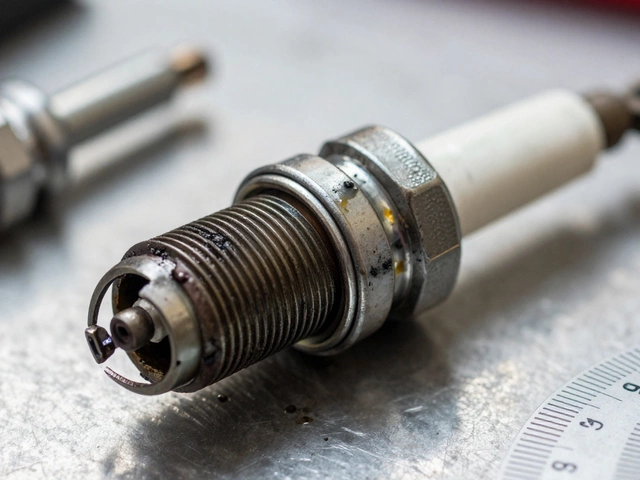Keeping your car’s engine in perfect shape isn’t just about external cleansing; it's an internal affair too. One of the key components that ensures your car's engine performs efficiently is the engine oil. It needs regular attention, but how do you know when it’s time for a change?
When oil is old or running low, it impacts your car’s performance, sometimes leading to costly repairs. Many drivers overlook the subtle signs that their engine oil is due for a refresh, which can push a vehicle beyond its limits.
In this article, we'll dive into the tell-tale signs indicating your engine is craving new oil. You'll also find practical tips on how to maintain its health. Let's embark on this journey to understand how keeping an eye on your engine oil can save major headaches down the road.
- Understanding Engine Oil
- Common Symptoms of Low or Old Engine Oil
- The Role of the Oil Change Light
- Checking Oil Level and Condition
- Importance of Regular Maintenance
- What to Do When in Doubt
Understanding Engine Oil
Engine oil plays a pivotal role in keeping your vehicle running smoothly, yet many people overlook its significance. Essentially, engine oil performs a myriad of functions that are crucial for any car owner to understand. It acts as a lubricant, coating the moving parts of your engine to reduce friction and prevent wear and tear. Without adequate lubrication, these metal parts would grind together, generating excessive heat and ultimately causing irreversible damage. Thus, ensuring your engine oil is well-maintained isn't just about performance—it’s fundamental to your car's survival.
Beyond lubrication, engine oil also serves as a coolant for your engine. It absorbs and dissipates heat, helping to maintain an optimal temperature and prevent overheating. In this way, oil has a dual role, lubricating the components while also mitigating some of the considerable heat produced during combustion. Additionally, oil contributes to engine cleanliness by trapping debris and contaminants, which can otherwise accumulate and cause damage. Once the oil gets too dirty, its efficiency diminishes, and this is why regular oil changes are imperative.
Another lesser-known function of engine oil is its ability to seal. Oil acts as a barrier in gaps between the cylinder walls and the pistons, helping to maintain compression and ensure efficient combustion. Without this sealing property, leakage could occur, leading to reduced performance. The role of engine oil in corrosion prevention also should not be underestimated. It protects the metallic parts from moisture and acids that could cause rust and corrosion over time, safeguarding the components to prolong their lifespan.
Types of Engine Oil
To cater to the diverse demands of engines, various types of engine oil have been developed, each suited to different vehicles and driving conditions. Conventional oil, derived from crude oil, offers adequate protection at a lower cost but is less effective under extreme conditions. On the other hand, synthetic oil is engineered for better performance, providing superior heat tolerance and more effective lubrication. It tends to be more expensive, but for high-performance engines or severe driving conditions, the investment can be worthwhile. Mixed oils, or synthetic blends, offer a middle ground, enhancing conventional oil with synthetic elements to boost performance at a more affordable price point.
Choosing the right oil for your vehicle involves considering these options in conjunction with the manufacturer's specifications and your typical driving conditions. The viscosity, or thickness, denoted by oil grades like 5W-30 or 10W-40, also plays a critical role. Proper viscosity ensures that oil flows effectively to protect the engine—thicker oils working well at higher temperatures and thinner oils suited to cooler climates. When in doubt, consulting your vehicle’s manual is wise, but knowledgeable mechanics or service personnel can also provide personalized advice given your driving habits.
"Your car's engine oil is akin to blood in a human body. It needs to be clean, at the right level, and the right type to keep your car driving smoothly," says Sandy Steenland, an automotive expert at National Lubrication Corporation.
Understanding these facets of engine oil not only aids in vehicle maintenance but empowers you to make informed decisions. Regularly assessing oil condition and knowing when to change it is integral for anyone who values the longevity of their vehicle. By doing so, you invest in not only your car’s current performance but prevent costly repairs or replacements in the future.
Common Symptoms of Low or Old Engine Oil
Every driver has that moment of unease, where they wonder if their car's issues might be engine oil-related. We'll dive into ways your vehicle tries to tell you something's amiss through specific symptoms. First and foremost, one classic sign is the distinct knocking or ticking noise. This often happens when an engine oil runs low. Inside your engine, components move against each other rapidly, and when there's insufficient oil to keep things slick, these parts start clattering. It’s their way of pleading for smoother interaction. Of course, noise isn't the only indicator; poor performance compliments the symphony of subtle hints.
When engine oil ages, not only does its volume diminish, but its ability to lubricate diminishes. How? Over time, oil picks up debris and residues, thickening and transforming into sludge. This sludge doesn’t lubricate well. Have you noticed the occasional flicker or glow of the oil change light on your dashboard? This tiny light isn't just for show—it's your car's warning that something's up. Ignore it long enough, and your vehicle may start developing a hard-to-miss symptom: reduced fuel efficiency. If your engine works harder, it burns more fuel, and no driver wishes to visit the pump more than necessary!
Moreover, don't neglect your exhaust. Look back at it during starts and idling; do you see any bluish smoke? This smoke signifies that old oil might be sneaking into combustion chambers and burning alongside fuel. It could be an innocent amount at first, but it's a red flag waving that it might be time for an oil change. Speaking of innocent signals, another little potential oversight is overheating. If your temperature gauge often sits higher than it used to, unchecked old oil might be close to boiling in fury.
According to the American Petroleum Institute: "Engine oil is not just a lubricant but also serves as a coolant." This is a reminder that even though oil isn’t typically considered part of a car's cooling system, it does help prevent overheating, underscoring its dual significance.Never overlook oil leaks, either. Though they might appear as small drips or stains left under your parked car, they suggest your sealing system is no longer airtight. These leaks often hint at deeper issues. Remember, small telltale signs should prompt timely responses. With attention to these details, maintaining your car becomes less of a burden and more of a well-oiled machine!
Given these issues, regular checking and timely oil changes are pivotal. How frequently should you inspect or change your engine oil? Depending on your vehicle, manufacturer recommendations generally sway every 5,000 to 10,000 miles. Real conditions and driving habits, however, can mean more frequent evaluations, particularly for vehicles with high mileage or those operating in extreme climates.
Temperature and Climate Factors
The outside environment plays a crucial role in your oil's lifespan. Vehicles in harsh cold or blistering heat will have different needs from those operating in mild conditions. In colder climates, engine oil must remain fluid at low temps, so its thickness matters. Conversely, in high heat, oil must resist thinning. In both extremes, checking your oil frequently ensures peace of mind and optimal performance.

The Role of the Oil Change Light
Every modern car comes equipped with an oil change light, a small yet significant component that serves as a vigilant guardian for your engine's health. While it's tempting to dismiss the glowing indicator as just another warning, it’s imperative to understand its crucial role in vehicle maintenance. The oil change light is designed to alert you when the oil's life approaches its end, ensuring you don’t overlook a change that could prevent major mechanical failures. It's not merely there for show; rather, it is calibrated to read a combination of your car's mileage, engine operating conditions, and elapsed time since the last oil change. This means it takes into account not just how far you've driven, but how you've driven.
Typically, when the oil change light illuminates, it signals that the oil has degraded to the point where it can no longer protect vital engine components as effectively as it should. Over time, as oil circulates through the engine, it loses viscosity, picks up dirt and debris, and its chemical properties start to break down. This leaves your engine vulnerable to wear and tear. It’s worth noting, however, that the light should not trigger panic but serve as a gentle reminder to check and possibly change your oil. "An illuminated oil light is a subtle nudge to give your car the care it needs," says automotive expert John Calder, emphasizing preventive maintenance's significance as a defense against engine problems.
Moreover, not all oil change lights are created equal; some newer vehicles come equipped with sensors that can accurately detect the precise quality and quantities of your engine oil. In contrast, others rely on pre-set intervals based on typical driving conditions. Understanding which system your vehicle uses can provide deeper insight into what the light truly indicates. In certain makes and models, these systems can even adjust the alerts based on driving habits—if you frequently embark on short trips, which are harder on the engine, or warm it up unusually long on chilly mornings, the light might come on sooner.
Not paying heed to the oil change light is a gamble that can introduce long-term ramifications. Once the oil ceases to lubricate effectively, increased friction inside the engine can escalate heat build-up, which, if prolonged, damages essential engine parts. It's a common misunderstanding to think that simply topping off old oil with fresh stock resolves the problem; in reality, it does little more than mask underlying issues. Regular and complete oil changes are key to preserving engine efficiency and longevity.
To see how such small signals can make an impact, consider the statistics provided by a leading auto maintenance network. According to their studies, vehicles that adhere to the scheduled oil changes marked by the oil change light were 30% less likely to require significant engine repairs within the first five years of ownership compared to those that ignored the notice.
Ultimately, treating the oil change light as a trustworthy advisor can dramatically enhance your engine's lifespan, reduce repair costs, and ensure that every journey remains smooth and reliable. Embracing this light’s guidance is akin to having a personal mechanic alert you before problems escalate; a savvy driver listens and acts accordingly.
Checking Oil Level and Condition
Knowing how to check your car's engine oil level is a fundamental skill for car owners. It’s not just about peeking at the dashboard warning lights and hoping they go off. To perform this essential task, start by making sure your car is parked on even ground to get an accurate reading. Once you're set, turn off the engine and wait a few minutes to allow the oil to settle. This simple step ensures you don't end up with an inaccurate measure due to oil still circulating through the engine. Next, find the oil dipstick in your vehicle – typically a bright-colored handle for easy identification – and pull it out.
Wipe the dipstick clean with a cloth or paper towel before reinserting it fully back into its tube. Then, draw it out again to check the oil level. The dipstick should have markings indicating the safe levels for your vehicle's engine. If the oil is below the minimum mark, it's time to top it off. Additionally, observe the oil's color and consistency. Fresh oil is usually amber, while dark or gritty oil might suggest it's time for a change. If you notice any particles or a burnt smell, there may be underlining issues needing attention. Some mechanics suggest the "wipe-and-check" process at least once a month or before long trips.
Interpreting the Dipstick Readings
Interpreting the dipstick's results goes beyond just understanding if there's enough oil present. The appearance of the oil is just as critical. If the oil appears milky, this could indicate a potential coolant leak. Consistency checks for thickness are also pertinent, as old oil tends to thicken, which can hinder engine performance. One often cited piece of wisdom, as expressed by automotive expert James Morgan, is "If you think you're too busy to check your oil, you might be even more inconvenienced by breakdowns in the future."
James Morgan emphasizes, "Regular oil checks are the easiest yet most skipped step in car maintenance."Keeping track of oil change intervals and familiarizing yourself with your engine's routine sounds, smells, and performance can also prevent unforeseen issues.
When to Seek Professional Advice
If ever in doubt about your oil's condition, consulting with a professional mechanic is advisable. They can measure more than just oil quantity; they assess the engine’s overall health being affected by oil quality. Regular inspections from professionals can uncover subtle issues before they escalate. During these checks, mechanics might also recommend specific types of engine oil that suit your vehicle’s make and model, which might sometimes differ from the manufacturer’s first fill. It’s beneficial to maintain a record of oil changes, noting the type, brand, and date, as this helps in diagnosing potential future problems. Remember, maintaining your vehicle’s engine oil level isn’t merely about preventing sudden stops; it maximizes your car’s longevity while ensuring an optimal driving experience.

Importance of Regular Maintenance
Regular engine oil maintenance might seem like a small chore, but its benefits resonate throughout your vehicle's lifespan. A well-maintained car engine not only ensures smoother rides but also prolongs the engine's life. Overlooking these tasks could mean more trips to the mechanic and emptier pockets. At its core, good maintenance acts as a preventive measure, catching potential problems before they spiral into bigger issues.
Oil lubricates the engine, reducing the friction between the moving parts. This process prevents wear and tear, which can otherwise lead to significant engine failures. An unchecked or ignored oil change can cause the oil to lose its viscosity and fail in its primary task of lubricating the engine. Picture the constant friction without oil’s soothing touch. Over time, the engine's components grind against each other ruthlessly, leading to irreversible damage. Not to mention, a neglected oil change directly affects the engine health and overall car efficiency.
"Prevention is better than cure. A simple oil change has the potential to save you thousands," notes Auto Expert James Morrison, emphasizing the financial and functional benefits of sticking to an oil change schedule.
Moreover, car maintenance isn’t only about avoiding future breakdowns. It’s also about ensuring your vehicle provides peak performance. Fresh oil adapts to and withstands high temperatures better than its older, thicker counterpart. It keeps the engine cool and prevents excessive heat build-up, which can be quite catastrophic to the engine’s integrity. Regularly changed oil ensures the engine runs smoothly, translating to lower fuel consumption and better mileage in the long run.
Another aspect to consider is the impact of clean oil on the environment. Old engine oil generates more emissions. By being diligent about maintenance, you contribute to a cleaner environment, reducing your car's carbon footprint. Considering all the factors at play, prioritizing engine oil changes can turn into a habit benefitting both your wallet and the world around you. Let's not forget that service records indicating regular maintenance can even significantly boost your car's resale value, should you decide to part ways with it down the road.
| Maintenance Task | Recommended Frequency |
|---|---|
| Engine Oil Change | Every 3,000-5,000 miles |
| Oil Filter Replacement | With every oil change |
| Tire Rotation | Every 7,500 miles |
In essence, treating regular maintenance as an investment, rather than an expense, can yield dividends of car longevity, reduced future repair costs, and optimized performance, ensuring that every trip you take is as enjoyable and smooth as your first. Committing to routine check-ups fosters relationship with your vehicle, making you a more responsible and aware driver. Next time you're contemplating skipping an oil change, remember the cascading benefits it brings both to your car and peace of mind.
What to Do When in Doubt
When you find yourself unsure about the state of your vehicle's engine oil, it's vital to take a cautious approach. Doubts about engine oil aren't just about your car’s well-being; it's about safety on the road. The first step is always to consult the car’s owner manual. These guides are treasure troves of specific information about your vehicle’s needs, including the recommended oil type and the frequency of oil changes. If your vehicle doesn't have an electronic oil monitor, the manual will show you the proper method to check the oil level manually, which is key in maintaining your car maintenance routine. Many modern vehicles, though, feature convenient built-in systems that alert you when oil life is low—trust these indicators as they're designed to warn before any serious damage can occur.
If you’re still not sure, consider visiting a reputable mechanic or dealership. These experts can not only provide a thorough inspection of your vehicle but might also teach you some handy checks you can perform yourself at home. Do not underestimate the importance of seeking professional help, as it could prevent irreversible damage to the engine. A regular check-up typically involves assessing the oil’s color and consistency, which is something you can learn to interpret. Remember, if the oil is dark and gritty to the touch, it's time for a change.
In some cases, you might be on the fence about whether to switch oil brands or formulations. A bit of research can go a long way, as can speaking to an expert who understands the intricacies of different gasoline additives and blends. Some vehicle owners swear by synthetic oils for their enhanced lubrication properties, which promote engine health over long periods. Others choose conventional oils based on specific driving conditions or habits, like frequent short trips or heavy towing. The choice between these products can depend on several factors, and understanding your driving patterns can guide you to the right decision.
Sometimes, despite using all tools at your disposal, the uncertainty may still linger. In such instances, it might help to understand a bit about the industry’s numbers. According to a recent survey, car owners who perform bi-annual oil checks reduce unexpected engine trouble by up to 30%. These statistics demonstrate the tangible benefits of diligent maintenance. Take these figures to heart as a reminder of the importance of proactive attention to engine oil.
Ultimately, staying informed is your best defense against the unexpected. Keep abreast of the latest automotive care trends and technologies. Subscribe to newsletters or follow trusted automotive blogs, which can sometimes provide timely tips on car care or updates on automotive innovations. You won't only be minimizing the odds of car troubles but investing in a more informed driving experience. Remember, car maintenance isn't just about the machinery—it's about the journey and everything in between. Equip yourself with knowledge, and those doubts will pave the way to smoother rides.








